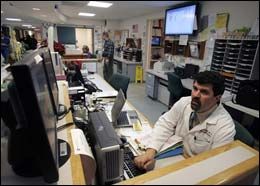By Valerie Bauman
Associated Press
Copyright 2008 The Associated Press
 AP Photo/ Mike Groll A doctor does his work in the ER of Adirondack Medical Center, N.Y., one of the state’s secluded medical outposts struggling to hire physicians due to big city competition. |
SARANAC LAKE, N.Y. — In secluded corners of upstate New York and impoverished neighborhoods around New York City, the sick are less likely to see a doctor.
Hours from a big city, and a helicopter ride away from certain specialized medical treatments, Adirondack Medical Center is one of New York’s medical outposts, struggling to compete with large metropolitan teaching hospitals when it comes to hiring physicians.
“It’s what keeps us awake at night,” AMC CEO Chandler Ralph said. “How are we going to get enough doctors to take care of our community?”
That question could be answered with a new idea Gov. Eliot Spitzer announced as part of his executive budget. He’s proposing an initiative to pay off student loans for doctors as a reward for working in underserved areas.
“Doctors Across New York” is supposed to help the more than 25 percent of New York’s population who live in areas designated as underserved, according to the governor’s office.
It would set aside $2 million a year to create a physician loan repayment program that would help as many to 100 doctors a year. If the doctor stays in an underserved area for the minimum requirement of two years, 30 percent of the loan would be paid off. Payments would grow each year to the point where it would be paid off after five years. The repayment maxes out at $150,000.
The Department of Health estimates that underserved areas need more than 300 primary care physicians just to escape the classification of “health professional shortage areas,” defined as more than 3,500 people for each physician.
In parts of New York City — within an hour of some of the best medical care in the world — the poor have limited access to care, or at least quality care, because of doctor shortages.
“The salaries are poor, the neighborhoods are poor and it’s not really an attractive place for people to go and work,” said Dr. Marcelo Venegas-Pizzarro, the chief medical officer for Housing Works. He works in parts of Brooklyn and New York City. Housing Works helps the poor, homeless and those living with HIV/AIDS.
But the need is great. In some cases, doctors who work in these areas do it because they want to serve needy populations, but that’s not always the case, Venegas-Pizzarro said.
“You see doctors that aren’t top notch doctors working in underserved areas because they can’t get other work,” he said.
Surrounded by sprawling woods and mountains, Saranac Lake is beautiful but isolated and, in winter, one of the coldest spots in the state. Adirondack Medical Center is based there, but has five satellite offices the region.
The Saranac Lake facility is modern, but little touches — like frames displaying nearly two decades of fish lures and arrows that had once been embedded in emergency room patients — are a reminder that this is a country community of just 5,000 people.
AMC needs to hire six doctors in various specialties. They currently have 48 physicians, but it’s a hostile recruiting environment.
They lost one doctor who was earning $150,000 a year to a Seattle practice that paid him $450,000 — plus a $50,000 signing bonus. Currently, half of all resident physicians leave New York state after completing their training.
The average physician in the United States graduating in 2006 had $130,571 in student loan debt, according to the American Medical Association. For New Yorkers graduating from a state public school that average is $129,000, according to the Spitzer administration. The average debt is $160,000 for those who attend private universities in New York.
Janice Charles is the executive director of the North Country Children’s Clinic in Watertown, which serves rural Franklin, Jefferson, Lewis and St. Lawrence Counties.
“We had to cut back on taking new patients here for a while because we had very limited physician time,” Charles said. “So that means patients had to do things like go to the emergency room in the hospital, which is a much more expensive visit.”
After turning new patients away, a new hire allowed the clinic to take on new patients again last October and November. Charles said the approximately 70 new patients represents the large number of people who were probably having limited treatment options until the staff change.
"(Patients) were not feeling so good when we had the shortages of staff,” Charles said. “Folks were frustrated that they couldn’t get in unless it was a real emergency.”
It can take more than a year to fill an empty position at the Adirondack Medical Center, Ralph said. Sometimes hospitals hire physicians to work as “temps” for as long as six months, but it costs 30 to 50 percent more.
Spitzer’s plan could bring the relief that rural and inner-city hospitals need. But hospital administrators will have to cross their fingers until the final budget comes out.
“I think everybody knows about the problem, they’ve recognized the challenge and they’re getting the best minds together to see what they can do,” Ralph said.











